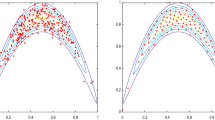Abstract
We consider the problem of the creation of the desired intensity distributions with the help of the Gerchberg-Saxton algorithm and hill-climbing algorithm with a constant and variable step. The efficiency of the algorithms for different input parameters is analyzed. For a better correction accuracy, two different hybrid methods are used: the first method consists of the successive use of the Gerchberg-Saxton algorithm after running the hill-climbing algorithm. In the second, more universal method, the Gerchberg-Saxton algorithm is built into the hill-climbing algorithm so that for each iteration of the latter there is a specified number of iterations of the former. The abovementioned algorithms treat the beams a few times more accurately when used in the hybrid regime than when used separately.
Similar content being viewed by others
References
C. E. Webb and J. D. C. Jones, Handbook of Laser Technology and Applications (Inst. Phys., Bristol, Philadelphia, 2004), Vol. 3, pp. 1559–1660.
S. A. Akhmanov, M. A. Vorontsov, V. P. Kandidov, A. P. Sukhorukov, and S. S. Chesnokov, “Thermal Self-Action of Light Beams and Compensation Methods,” Izv. Vyssh. Uchebn. Zaved., Ser. Radiofiz. 23, 1–37 (1980).
W. M. Steen, Laser Material Processing (Springer, London, 2003).
O. Bryngdahl, “Optical Map Transformations,” Opt. Commun. 10(2), 164–166 (1974).
N. Nakajima, “Phase-Retrieval System Using a Shifted Gaussian Filter,” J. Opt. Soc. Amer. A 15(2), 402–406 (1998).
R. W. Gerchberg and W. O. Saxton, “A Practical Algorithm for the Determination of Phase from Image and Diffraction Plane Pictures,” Optik (Stuttgart) 35(2), 237–246 (1972).
J. R. Fienup, “Phase Retrieval Algorithms: A Comparison,” Appl. Opt. 21(15), 2758–2769 (1982).
F. M. Dickey and S. C. Holswade, Laser Beam Shaping: Theory and Techniques (CRC Press, 2000), pp. 215–248.
K. Nemoto, T. Fujii, N. Goto, T. Nayuki, and Y. Kanai, “Transformation of a Laser Beam Intensity Profile by a Deformable Mirror,” Opt. Lett. 21(3), 168–170 (1996).
F. M. Dickey, S. C. Holswade, and D. L. Shealy, Laser Beam Shaping Applications (CRC Press, 2006), pp. 269–303.
J. R. Fienup, “Reconstruction of an Object from the Modulus of Its Fourier Transform,” Opt. Lett. 3(1), 27–29 (1978).
M. T. Eismann, A. M. Tai, and J. N. Cederquist, “Iterative Design of a Holographic Beam Former,” Appl. Opt. 28, 2641–2650 (1989).
G. Zhou, X. Yuan, P. Dowd, Y.-L. Lam, and Y.-C. Chan, “Design of Diffractive Phase Elements for Beam Shaping: Hybrid Approach,” J. Opt. Soc. Am. A 18(4), 791–800 (2001).
V. P. Sivokon’, “Formation of Light Beams of Zadannoi Structure for Problems of Laser Technology,” Candidate’s Dissertation in Mathematical Physics (1986).
G. Z. Yang, B. Z. Dong, B. Y. Gu, J. Y. Zhuang, and O. K. Ersoy, “Gerchberg-Saxton and Yang-Gu Algorithm for Phase Retrieval in Nonunitary Transform System: A Comparison,” Appl. Opt. 33(2), 209–218 (1994).
Author information
Authors and Affiliations
Additional information
Original Russian Text © A.S. Mikryukov, I.V. Il’ina, T.Yu. Cherezova, 2010, published in Optica Atmosfery i Okeana.
Rights and permissions
About this article
Cite this article
Mikryukov, A.S., Il’ina, I.V. & Cherezova, T.Y. Creation of desired intensity distributions. Part 1: The Gerchberg-Saxton algorithm, hill-climbing algorithm, and their combination. Atmos Ocean Opt 23, 229–235 (2010). https://doi.org/10.1134/S1024856010030127
Received:
Published:
Issue Date:
DOI: https://doi.org/10.1134/S1024856010030127




